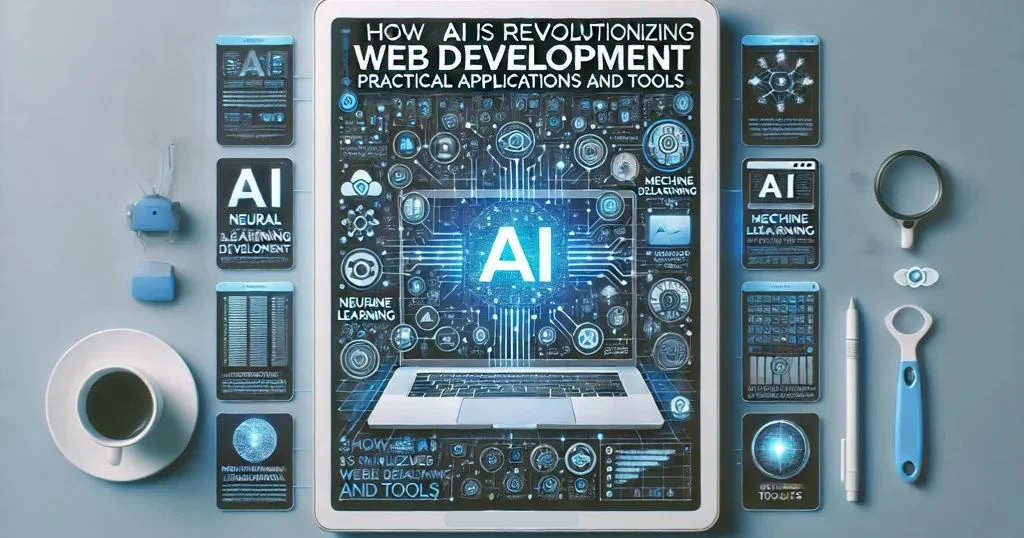In the last decade, artificial intelligence (AI) has evolved from an experimental technology to a transformative force shaping numerous industries. In web development, AI is no longer a novelty but a necessity, empowering developers with tools that make coding faster, more efficient, and more innovative. By automating complex tasks, improving user experiences, and increasing security, AI is not just a supplementary tool but a driver of fundamental changes in web development. This blog will delve into practical applications and the latest tools where AI is making an impact, along with insights into how developers can leverage AI to build smarter, more robust, and user-friendly websites.
1. Automated Code Generation
AI-powered code generation is a game-changer for web development. Automated code generation tools allow developers to quickly generate lines of code, enabling them to focus on more complex aspects of development. These tools not only speed up coding but also improve accuracy by minimizing errors.
Practical Tools and Applications
- GitHub Copilot: Trained on billions of lines of public code, GitHub Copilot suggests code snippets and entire functions as developers type, making it a valuable assistant for coding tasks. It works across multiple languages and IDEs, including Visual Studio Code.
- Tabnine: Tabnine uses machine learning to autocomplete code, offering context-aware suggestions. It’s popular among web developers for its ability to integrate with various IDEs, providing suggestions based on the codebase and even custom libraries.
These tools make coding faster and more efficient, helping developers adhere to coding best practices without needing to write code from scratch. This automation enables teams to work more productively, reducing the time spent on repetitive coding tasks.
2. Improved User Experience with AI-Powered Personalization
One of AI’s most valuable contributions to web development is personalized content. AI can analyze user behavior and tailor content, product recommendations, and even web design layouts to meet individual preferences. This form of personalization is particularly beneficial for e-commerce sites, blogs, and other platforms where content customization can enhance engagement.
Practical Tools and Applications
- Dynamic Yield: This tool enables businesses to personalize their websites by analyzing visitor behavior and preferences. It can dynamically change content, layouts, and products displayed, ensuring that each user experiences a custom-tailored interface.
- Adobe Target: Adobe Target uses machine learning to test and optimize web content in real-time. It helps web developers deliver personalized experiences by analyzing user data and generating personalized recommendations.
By integrating personalization into websites, developers can increase user engagement, reduce bounce rates, and improve customer retention. AI-powered personalization is essential for building strong, user-centered web experiences that adapt to individual user needs and preferences.
3. Chatbots and Virtual Assistants for Enhanced Interactivity
Chatbots have become a standard feature on websites, particularly in e-commerce, customer service, and educational sectors. Modern AI-powered chatbots can perform various functions, from answering user queries to providing product recommendations, scheduling appointments, and even completing transactions.
Practical Tools and Applications
- Dialogflow: Powered by Google, Dialogflow enables developers to design conversational interfaces. It uses NLP (Natural Language Processing) to understand and respond to user queries effectively, making it a powerful tool for creating complex chatbots.
- Watson Assistant: IBM’s Watson Assistant is an AI chatbot platform that can be integrated into websites to provide robust, context-aware customer support. Watson learns from previous interactions, making it an ideal solution for companies that need advanced customer service automation.
These tools help developers build chatbots that enhance user engagement, provide 24/7 support, and reduce operational costs. Chatbots not only improve customer satisfaction but also allow websites to serve as comprehensive, self-contained service platforms.
4. AI in Testing and Quality Assurance
Quality assurance and testing are crucial stages in web development. However, manual testing can be time-consuming and prone to errors. AI-driven testing tools can automatically detec bugs, performance issues, and compatibility problems across different devices and browsers,
ensuring that websites are optimized for all users.
Practical Tools and Applications
- Testim: Testim uses AI to automate the process of web application testing. Its machin learning algorithms help detect and adapt to changes in the web application’s structure, making it an efficient tool for regression testing and functional testing.
- Applitools: Applitools is an AI-powered visual testing tool that helps developers verify that a website appears correctly across different devices and resolutions. It identifies UI inconsistencies that manual testing might overlook.
By integrating AI-driven testing tools, developers can enhance testing speed, accuracy, and coverage, ensuring the delivery of high-quality, bug-free websites. This approach not only improves the user experience but also saves resources and shortens the development cycle.
5. SEO Optimization Using AI
Search engine optimization (SEO) is vital for increasing website visibility. AI tools in SEO help developers and digital marketers analyze search trends, identify keywords, and optimize on-page elements to improve rankings. AI also helps in predicting SEO performance and
making data-driven decisions for content creation and website structuring.
Practical Tools and Applications
- MarketMuse: This AI tool helps content strategists and developers identify content gaps and optimize websites for SEO. It generates keyword suggestions and content ideas, enhancing a site’s relevance and reach.
- Frase: Frase uses AI to analyze user intent, suggesting keywords and phrases that match search engine queries. It also provides insights into competitors’ content strategies, helping websites stay competitive in search rankings.
With AI-driven SEO tools, developers can create websites that perform better in search engine rankings, attract more organic traffic, and provide valuable content to users. This is essential
for businesses looking to maximize their online visibility and engagement.
6. AI for Image and Video Recognition
Images and videos are integral to modern web design, but they also present challenges in terms of accessibility, relevance, and SEO. AI can help developers make the most of multimedia content by recognizing images, generating alt text for accessibility, and even providing tagging and categorization for better search visibility.
Practical Tools and Applications
- Cloudinary: Cloudinary uses AI to automatically tag and categorize images, optimize media formats, and enhance load times. It also provides accessibility support by generating descriptive alt text for images.
- Google Vision API: This tool analyzes images, detects objects and faces, and extracts text from images. It’s useful for adding descriptive metadata to multimedia content, which can improve both accessibility and searchability.
AI in multimedia handling can help developers streamline content management, improve accessibility, and enhance the overall user experience. This is particularly useful for websites with large image libraries or those that rely heavily on visual content.
7. AI-Driven Security and Threat Detection
Security is paramount in web development, as data breaches and cyberattacks continue to pose significant risks. AI can detect threats in real-time, analyze traffic patterns to identify anomalies, and prevent malicious activity. AI-powered security solutions can safeguard both
websites and their users’ data, reducing the risks of attacks.
Practical Tools and Applications
- Darktrace: Darktrace uses machine learning to detect, respond to, and mitigate cyber threats in real-time. Its AI algorithms identify unusual patterns in website traffic and take proactive measures to prevent breaches.
- Cloudflare: Known for its powerful DDoS protection, Cloudflare uses AI to detect and filter out malicious traffic. It provides an added layer of security, ensuring that only legitimate traffic reaches the site.
AI in security allows developers to build robust, threat-resistant websites, instilling trust among users. This is particularly valuable for e-commerce websites and other platforms that handle sensitive user data.
8. Natural Language Processing (NLP) for Content Analysis
NLP is transforming how websites understand and respond to user-generated content. From analyzing reviews and social media comments to generating dynamic content based on user preferences, NLP helps websites engage users more meaningfully by “understanding” their
language.
Practical Tools and Applications
- Text Razor: TextRazor uses NLP to analyze text, extract topics, and identify key phrases. This is particularly useful for content-heavy websites that aim to provide tailored content based on user interests.
- OpenAI’s GPT API: The GPT API can be used to generate content, summarize information, and even power chatbots. It provides a way for websites to create dynamic, AI-generated content that resonates with users.
By leveraging NLP, developers can create interactive, language-driven websites that engage users and respond to their inputs in real time. NLP is especially beneficial for content-rich platforms, news sites, and blogs.
9. Predictive Analytics for User Behavior
AI-powered predictive analytics enables websites to forecast user behavior, providing insights into what users might do next. This can be incredibly valuable for personalization, marketing strategies, and UX design.
Practical Tools and Applications
- Google Analytics with AI Integration: Google Analytics uses machine learning algorithms to predict user behavior patterns, helping developers understand how users interact with the website and what improvements can be made.
- Salesforce Einstein: Salesforce Einstein provides predictive analytics and personalization capabilities for websites, helping brands understand user preferences and behaviors in real-time.
Predictive analytics enables developers to create proactive, user-centered designs that anticipate user needs and preferences, enhancing the overall user experience.
10. Voice Search Optimization and VUI Development
With the rise of voice search and smart assistants, optimizing websites for voice user interfaces (VUI) is becoming crucial. AI can help websites interpret voice commands accurately, enabling users to navigate sites with voice search.
Practical Tools and Applications
- Speechly: Speechly offers real-time voice recognition that can be integrated into websites, allowing users to interact with sites through voice commands.
- Alexa Skills Kit: This toolkit enables developers to build voice commands for Alexa-enabled devices, helping websites reach a broader audience through smart home devices.
Voice search optimization can make websites more accessible and user-friendly, especially for users who prefer hands-free interaction.
Conclusion
AI is reshaping web development by automating tasks, personalizing experiences, and enhancing security. These AI-driven innovations enable developers to create websites that are not only more efficient and user-friendly but also smarter and more adaptive to user needs. By integrating AI tools and applications into web development, developers can stay ahead in the fast-evolving digital landscape, creating ebsites that truly stand out in terms of performance, user experience, and functionality.





